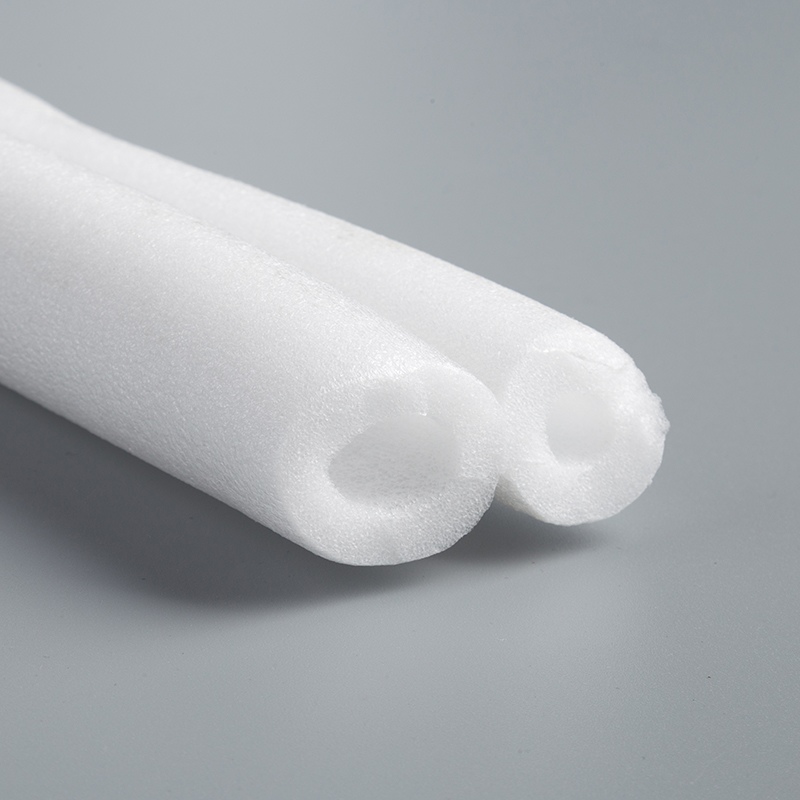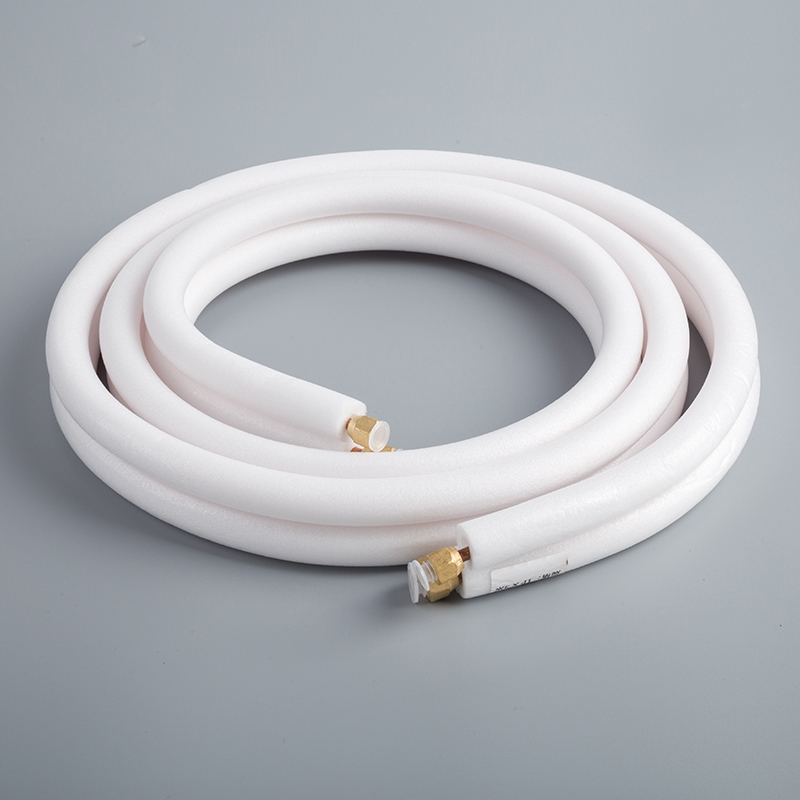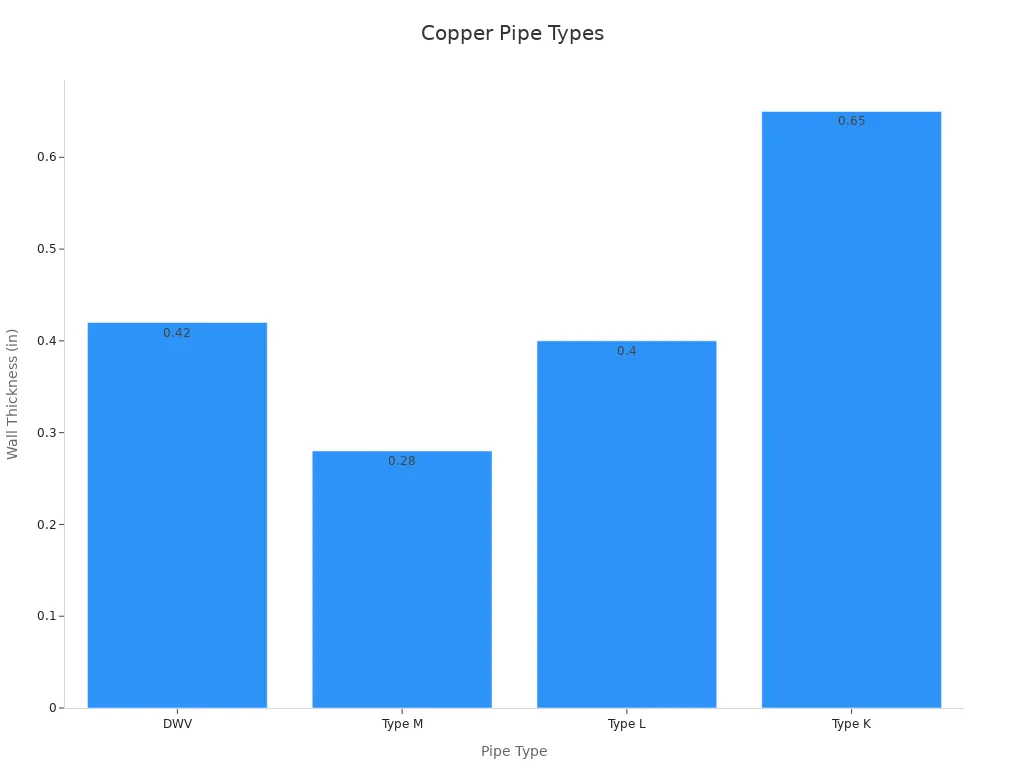What Are the Types of Copper Pipes Used in HVAC Systems in 2025

Copper pipes play a crucial role in ensuring HVAC systems operate efficiently. As a leading HVAC copper pipe manufacturer in India, the industry focuses on producing pipes that resist rust, enhancing their durability. These pipes also possess germ-fighting properties, keeping systems cleaner and reducing maintenance costs. By 2025, copper remains an eco-friendly option due to its recyclability, making it an excellent choice for heating, cooling, and ventilation needs. HVAC copper pipe manufacturers in India are innovating with new designs, such as bendable and insulated pipes, to cater to diverse requirements. Selecting the right pipe involves considering your system's needs, environmental impact, and budget.
Key Takeaways
Copper pipes are important for HVAC systems because they last long, work well, and don’t rust. They keep air cleaner and lower repair costs.
There are three main kinds of copper pipes: Type K (thickest and strongest), Type L (medium thickness and bendable), and Type M (thinnest and cheapest). Pick one based on your system’s needs.
Insulated copper pipes save energy by keeping refrigerants cool and stopping moisture. Flexible copper pipes are easier to install in small spaces and help prevent leaks.
To pick the right copper pipe, think about your HVAC system, the weather, and your budget. Taking care of pipes helps them work better and last longer.
In 2025, copper is still a great choice for HVAC systems. It’s eco-friendly, saves energy, and helps cut down on pollution.
Why Copper Pipes Are Important in HVAC Systems
Main Benefits of Copper Pipes in HVAC
Copper pipes are very useful for HVAC systems. They are a key part of modern heating, cooling, and ventilation setups. You can use them in many ways, like in air conditioners or heating systems. They come in different sizes to fit various system needs.
Copper pipes work well without causing problems. They don’t rust, so they last longer. They transfer heat quickly, making energy use more efficient. Unlike other materials, copper pipes are simple to connect and install, saving time during setup.
Copper is strong and needs less fixing over time. It handles changes in temperature and pressure without breaking. Since copper is widely available, it’s also an eco-friendly choice. Using copper pipes means you get a material that is efficient, reliable, and good for the environment.
Why Copper Is Still the Best in 2025
In 2025, copper is still the top choice for HVAC systems. It is strong and doesn’t rust, so it lasts a long time. Small copper tubes save materials while keeping energy use efficient. This matches the need for greener technology.
Special grooved copper coils make heat exchange better. These coils give more surface area for refrigerants, improving air conditioner performance by up to 50%. Copper’s ability to transfer heat well makes it perfect for heat exchangers.
Copper also stops bacteria from growing, helping HVAC systems circulate cleaner air. Its flexibility makes installation easier, even around obstacles. This reduces the need for extra joints that might cause leaks. With these benefits and its role in cutting carbon emissions, copper remains the best material for HVAC systems in 2025.
Types of Copper Pipes Used in HVAC Systems

Choosing the right copper pipes for HVAC is important. Different types work best for specific uses. Here are the main types: Type K, Type L, and Type M.
Type K Copper Pipes
Type K pipes are the thickest and strongest copper pipes. They are very durable and work well under high pressure. These pipes are often used underground, in city water systems, and for HVAC refrigerants.
Main features of Type K pipes:
Great at moving heat, which saves energy in HVAC systems.
Resist rust, so they last longer in tough conditions.
Thick walls handle high pressure, lowering the chance of leaks.
Using Type K pipes can cut energy use and repair costs. They are easy to spot because of their green color code.
Type | Wall Thickness | Uses | Color Code |
|---|---|---|---|
Type K | Thickest | Underground, city water, HVAC refrigerant lines | Green |
Type L Copper Pipes
Type L pipes are strong and flexible, making them very useful. They have medium-thick walls, which balance strength and ease of use. These pipes are great for indoor plumbing, drinking water, and HVAC systems.
Key points about Type L pipes:
Can handle 1,002 pounds per square inch at 100°F.
Good for fixing or replacing old water pipes.
Work well for outdoor above-ground setups.
The blue color code helps identify Type L pipes. Their medium thickness makes them popular for homes and businesses.
Property | Value |
|---|---|
Type of Pipe | Type L |
Wall Thickness | Thinner than Type K, thicker than Type M |
Pressure Rating at 100°F | 1,002 pounds per square inch |
Type M Copper Pipes
Type M pipes have the thinnest walls, making them the cheapest option. They are best for low-pressure jobs like indoor water and drainage. While not as strong as other types, they work fine if installed properly.
Features of Type M pipes:
Thin walls lower material costs, saving money.
Less durable, so they may need replacing sooner.
Best for low-pressure uses like home plumbing and drains.
Type M pipes are marked with a red color code for easy identification. They are not ideal for high-pressure HVAC systems but are good for budget-friendly projects.
Type | Wall Thickness | Uses | Color Code |
|---|---|---|---|
Type M | Thinner | Indoor water, drains, home plumbing | Red |
Knowing these pipe types helps you pick the best one. Each type has its own strengths, ensuring your HVAC system works well and efficiently.
Specialized Copper Pipes (Insulated and Flexible)
Special copper pipes, like insulated and flexible ones, are now key in HVAC systems. These pipes solve specific problems and make systems work better. Knowing their features helps you choose the right one for your needs.
Insulated Copper Pipes
Insulated pipes keep refrigerants at the right temperature as they move. This helps maintain steady cooling and heating, saving energy. They stop moisture from forming, which prevents rust and makes systems last longer. These pipes also shield against bad weather, making them great for outdoor use.
A big benefit of insulated pipes is saving energy. Less energy waste means lower power bills, making them a smart choice for homes and businesses. If you want a stronger and more efficient HVAC system, insulated pipes are a great pick.
Flexible Copper Pipes
Flexible pipes are easy to use during installation. They bend to fit tight spaces and tricky corners. Unlike stiff pipes, they need fewer joints, which lowers the chance of leaks.
These pipes are also very strong. They resist rust and chemical damage, lasting a long time. Their good heat transfer improves cooling performance. If your HVAC system has a tough layout, flexible pipes are the best option.
Comparing Features of Insulated and Flexible Copper Pipes
The table below shows the main features of insulated and flexible pipes. This helps you see what makes each type special:
Feature | Insulated Copper Pipes | Flexible Copper Pipes |
|---|---|---|
Moisture Prevention | Stops moisture, preventing rust | N/A |
Temperature Maintenance | Keeps refrigerants steady for better cooling | Helps with heat transfer for cooling |
Durability | Protects from weather damage | Resists rust and chemicals |
Installation | N/A | Fits tricky spaces easily |
Energy Efficiency | Saves energy, lowering power costs | N/A |
Using both insulated and flexible pipes can make your HVAC system efficient and adaptable. Each type has a role, helping your system work well in different situations.
Characteristics and Uses of Different Copper Pipes
Strength and Thickness of Type K, L, and M Pipes
Picking the right copper pipes for HVAC systems is important. Their strength and thickness decide how well they work. The three main types—Type K, Type L, and Type M—each have special features.
Type K pipes are the strongest because they have thick walls. They handle high pressure and are great for tough jobs like underground work and refrigeration. Type L pipes are medium-thick, making them strong but flexible. These are often used in homes and businesses for water supply. Type M pipes are the thinnest and cheapest. They are best for low-pressure tasks like heating in houses or offices.
Here’s a quick look at their features and uses:
Type | Wall Thickness | Common Uses |
|---|---|---|
K | Thickest | Underground work, refrigeration systems |
L | Medium | Water supply in homes and businesses |
M | Thinnest | Low-pressure heating in homes and small buildings |
HVAC Jobs for Each Pipe Type
Each copper pipe type fits certain HVAC jobs. Type K pipes are perfect for high-pressure tasks like refrigerant lines. Their thick walls stop leaks and rust, making them last longer. Type L pipes are flexible and work well for indoor water lines in HVAC systems. They handle medium pressure and suit both homes and businesses. Type M pipes are good for low-pressure jobs like drainage or small plumbing lines.
For heavy-duty HVAC systems, Type K is the best pick. For general use, Type L offers a good mix of strength and cost. If you’re on a budget and need low-pressure pipes, Type M is a smart choice.
Eco-Friendly and Energy-Saving Trends in 2025
In 2025, saving energy and protecting the planet are big goals. Copper pipes help HVAC systems use less energy and cut pollution. New chillers with chlorine-free refrigerants are 30-40% more efficient than older ones. This change helps the environment and supports global green goals.
Copper pipes also save money. Switching to modern chillers can cut energy use by up to 50%. Tax breaks make it easier for building owners to upgrade to eco-friendly systems.
Here’s a summary of key points for copper pipes in HVAC:
Metric | Details |
|---|---|
Energy Efficiency | New chillers with chlorine-free refrigerants are 30-40% more efficient than older models. |
Emissions Reduction | Switching to non-CFC systems reduces harm to the environment. |
Cost Savings | Modern systems can save 15-35% energy, up to 50% with smaller chillers. |
Tax Incentives | Proposed tax breaks help owners afford eco-friendly upgrades. |
Choosing the right copper pipes improves HVAC efficiency and helps the planet.
How to Choose the Right Copper Pipe for Your HVAC System
Evaluating System Requirements
Picking the right copper pipe means knowing your HVAC system's needs. Each system is different based on pressure, temperature, and use. For example, thicker pipes like Type K work for high-pressure systems. Residential systems often use Type L pipes.
Follow these tips to keep your system running well:
Expansion Loops: Copper pipes change size with heat. Use special joints to stop bending or breaking.
Tube Supports: Support pipes every 8 feet for 1-inch sizes. Larger pipes need support every 10 feet to avoid sagging.
Resistance to Crushing: Copper pipes can handle a lot of pressure without breaking. This makes them strong and reliable.
Water Hammer: Sudden stops in water flow can damage pipes. Design your system to avoid this problem.
The table below shows pipe thickness and uses. This helps you pick the right pipe for your system:
Type | Wall Thickness (in) | Applications |
|---|---|---|
DWV | 0.42 | Best for drains and vents; PVC/ABS is cheaper. |
Type M | 0.28 | Good for home water supply and HVAC systems. |
Type L | 0.40 | Works for water and gas lines; used where Type M is not allowed. |
Type K | 0.65 | Strongest for underground jobs; not common indoors. |

By checking these details, you can choose a pipe that fits your system and lasts a long time.
Considering Environmental Conditions
Where your HVAC system is located affects the pipe choice. Outdoor systems face weather, moisture, and temperature changes. Insulated copper pipes are great for these setups. They keep refrigerants steady, stop rust, and last longer.
For tight spaces or tricky layouts, flexible copper pipes are helpful. They bend easily, need fewer joints, and lower the chance of leaks. These pipes resist rust and chemicals, making them good for humid or corrosive areas.
Think about how the environment affects the pipe. For example:
Outdoor Systems: Use insulated pipes to protect against weather and save energy.
Indoor Systems: Type L pipes are strong and flexible, perfect for indoor use.
Tight Spaces: Flexible pipes make installation easier and reduce weak spots.
Matching the pipe to the environment improves your HVAC system's efficiency and lifespan.
Balancing Budget and Performance
Finding the right balance between cost and quality is important. Thicker pipes like Type K are strong but expensive. Thinner pipes like Type M cost less but may not last as long. Type L pipes are a good middle option for homes and businesses.
To save money and get good performance, consider these tips:
Regular checks prevent big repairs and keep your system working longer.
Energy-saving systems cut power use and lower bills over time.
Predictive maintenance avoids breakdowns and keeps performance steady.
Smart tools like thermostats find problems and improve efficiency.
Flexible pipes can save money during installation by needing fewer fittings. Insulated pipes lower energy costs by keeping refrigerants steady. Spending more upfront on the right pipe can save money in the long run.
By comparing costs and performance, you can pick a pipe that works well and fits your budget.
Copper pipes are key to HVAC systems because they are reliable and efficient. They also fight germs, making indoor air cleaner and safer. This lowers risks like Legionnaire's Disease and other harmful microbes.
In 2025, the HVAC industry focuses on saving energy and being eco-friendly. Key trends include:
Using electric heat pumps powered by renewable energy.
Smart systems that improve energy use and comfort.
Benefit | Use Case |
|---|---|
Cleans indoor air | Cuts down germs and bacteria in HVAC systems. |
Protects health | Helps people with weak immune systems by stopping germ growth. |
Stops bacterial outbreaks | Blocks harmful bacteria like those causing Legionnaire's Disease. |
Knowing these updates helps you choose better options for a greener future.
FAQ
Why are copper pipes good for HVAC systems?
Copper pipes don’t rust and move heat well. They last longer and need less fixing. They are easy to install and eco-friendly, making them great for today’s HVAC systems.
Can copper pipes carry water and oil?
Yes, copper pipes can carry both water and oil. They are strong and don’t rust, so they work well for homes and industries.
What is a DWV copper pipe used for?
DWV copper pipes are for drains, waste, and vents. They are light and cheap, perfect for plumbing jobs without pressure in homes or buildings.
How do insulated copper pipes help HVAC systems?
Insulated pipes keep refrigerants at the right temperature and stop moisture. This saves energy and helps HVAC systems last longer and work better.
Are flexible copper pipes good for small spaces?
Flexible copper pipes are great for tight spots. They bend easily, need fewer joints, and lower the chance of leaks. This makes them quick and simple to install.
See Also
Explore 5 Innovative Benefits of Copper Pipes in AC Systems
The Impact of Pure Copper Pipes on Air Conditioning
Reasons to Opt for Copper Pipes in Your AC


